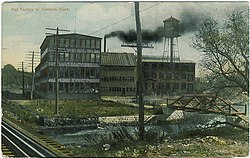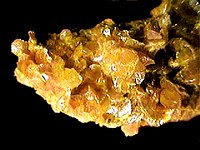Fragmentation and destruction of Great Ape habitat in Central Africa, from the GLOBIO and GRASP projects. Areas shown in black and red delineate areas of severe and moderate habitat loss, respectively.
Habitat fragmentation describes the emergence of discontinuities (fragmentation) in an organism's preferred environment (habitat), causing population fragmentation and ecosystem decay. Causes of habitat fragmentation include geological processes that slowly alter the layout of the physical environment
(suspected of being one of the major causes of speciation),and human activity such as land conversion, which can alter the environment much faster and causes the extinction of many species.
Deforestation and increased road-building in the Amazon Rainforest
are a significant concern because of increased human encroachment upon
wild areas, increased resource-extraction and further threats to biodiversity.
Definition
The term habitat fragmentation includes five discrete phenomena:
- Reduction in the total area of the habitat
- Decrease of the interior: edge ratio
- Isolation of one habitat fragment from other areas of habitat
- Breaking up of one patch of habitat into several smaller patches
- Decrease in the average size of each patch of habitat
"fragmentation ... not only causes loss of the amount of habitat, but
by creating small, isolated patches it also changes the properties of
the remaining habitat" (van den Berg et al. 2001).
Habitat fragmentation is the landscape level of the phenomenon, and
patch level process. Thus meaning, it covers; the patch areas, edge
effects, and patch shape complexity.
In scientific literature, there is some debate whether the term
"habitat fragmentation" applies in cases of habitat loss, or whether the
term primarily applies to the phenomenon of habitat being cut into
smaller pieces without significant reduction in habitat area. Scientists
who use the stricter definition of "habitat fragmentation" per se
would refer to loss of habitat area as "habitat loss" and explicitly
mention both terms if describing a situation where the habitat becomes
less connected and there is less overall habitat.
Causes
Natural causes
Evidence of habitat destruction through natural processes such as volcanism, fire, and climate change is found in the fossil record. For example, habitat fragmentation of tropical rainforests in Euramerica
300 million years ago led to a great loss of amphibian diversity, but
simultaneously the drier climate spurred on a burst of diversity among
reptiles.
Human causes
Habitat fragmentation is frequently caused by humans when native plants is cleared for human activities such as agriculture, rural development, urbanization and the creation of hydroelectric
reservoirs. Habitats which were once continuous become divided into
separate fragments. After intensive clearing, the separate fragments
tend to be very small islands isolated from each other by cropland,
pasture, pavement, or even barren land. The latter is often the result
of slash and burn farming in tropical forests. In the wheat belt of central western New South Wales, Australia, 90% of the native vegetation has been cleared and over 99% of the tall grass prairie of North America has been cleared, resulting in extreme habitat fragmentation.
Endogenous vs. exogenous
There
are two types of processes that can lead to habitat fragmentation.
There are exogenous processes and endogenous processes. Endogenous are
process that develop as a part of a species biology so they typically
include changes in biology, behavior and interactions within or between
species. Endogenous threats can result in changes to breeding patterns
or migration patterns and are often triggered by exogenous processes.
Exogenous processes are independent of species biology and can include
habitat degradation, habitat subdivision or habitat isolation. These
processes can have a substantial impact on endogenous processes by
fundamentally altering species behavior. Habitat subdivision or
isolation can lead to changes in dispersal or movement of species
including changes to seasonal migration. These changes can lead to
decrease in a density of species, increased competition or even
increased predation.
Implications
Habitat Loss and Biodiversity
One of the major ways that habitat fragmentation affects biodiversity is by reducing the amount of suitable habitat available for organisms. Habitat fragmentation often involves both habitat destruction and the subdivision of previously continuous habitat. Plants and other sessile
organisms are disproportionately affected by some types of habitat
fragmentation because they cannot respond quickly to the altered spatial
configuration of the habitat.
Habitat loss, which can occur through the process of habitat fragmentation, is considered to be the greatest threat to species.
But, the effect of the configuration of habitat patches within the
landscape, independent of the effect of the amount of habitat within the
landscape (referred to as fragmentation per se), has been suggested to be small.
A review of empirical studies found that, of the 381 reported
significant effect of habitat fragmentation per se on species
occurrences, abundances or diversity in the scientific literature, 76%
were positive whereas 24% were negative. Despite these results, the scientific literature tends to emphasize negative effects more than positive effects.
Positive effects of habitat fragmentation per se imply that several
small patches of habitat can have higher conservation value than a
single large patch of equivalent size. Land sharing strategies could therefore have more positive impacts on species than land sparing strategies.
Habitat fragmented by numerous roads near the Indiana Dunes National Lakeshore.
Area is the primary determinant of the number of species in a fragment
and the relative contributions of demographic and genetic processes to
the risk of global population extinction depend on habitat
configuration, stochastic environmental variation and species features.
Minor fluctuations in climate, resources, or other factors that would
be unremarkable and quickly corrected in large populations can be
catastrophic in small, isolated populations. Thus fragmentation of
habitat is an important cause of species extinction. Population dynamics of subdivided populations tend to vary asynchronously.
In an unfragmented landscape a declining population can be "rescued" by
immigration from a nearby expanding population. In fragmented
landscapes, the distance between fragments may prevent this from
happening. Additionally, unoccupied fragments of habitat that are
separated from a source of immigrants by some barrier are less likely to be repopulated than adjoining fragments. Even small species such as the Columbia spotted frog
are reliant on the rescue effect. Studies showed 25% of juveniles
travel a distance over 200m compared to 4% of adults. Of these, 95%
remain in their new locale, demonstrating that this journey is necessary
for survival.
Additionally, habitat fragmentation leads to edge effects.
Microclimatic changes in light, temperature and wind can alter the
ecology around the fragment, and in the interior and exterior portions
of the fragment. Fires
become more likely in the area as humidity drops and temperature and
wind levels rise. Exotic and pest species may establish themselves
easily in such disturbed environments, and the proximity of domestic
animals often upsets the natural ecology. Also, habitat along the edge
of a fragment has a different climate and favours different species from
the interior habitat. Small fragments are therefore unfavourable for
species which require interior habitat. The percentage preservation of
contiguous habitats is closely related to both genetic and species
biodiversity preservation. Generally a 10% remnant contiguous habitat
will result in a 50% biodiversity loss.
Informed Conservation
Habitat fragmentation is often a cause of species becoming threatened or endangered.
The existence of viable habitat is critical to the survival of any
species, and in many cases the fragmentation of any remaining habitat
can lead to difficult decisions for conservation biologists. Given a
limited amount of resources available for conservation is it preferable
to protect the existing isolated patches of habitat or to buy back land
to get the largest possible continuous piece of land. In rare cases a conservation reliant species
may gain some measure of disease protection by being distributed in
isolated habitats. This ongoing debate is often referred to as SLOSS (Single Large or Several Small).
One solution to the problem of habitat fragmentation is to link the fragments by preserving or planting corridors of native vegetation. In some cases, a bridge or underpass may be enough to join two fragments. This has the potential to mitigate the problem of isolation but not the loss of interior habitat.
Another mitigation measure is the enlargement of small remnants
in order to increase the amount of interior habitat. This may be
impractical since developed land is often more expensive and could
require significant time and effort to restore.
The best solution is generally dependent on the particular
species or ecosystem that is being considered. More mobile species, like
most birds, do not need connected habitat while some smaller animals,
like rodents, may be more exposed to predation in open land. These
questions generally fall under the headings of metapopulations island biogeography.
Genetic Risks
As the remaining habitat patches are smaller, they tend to support smaller populations of fewer species. Small populations are at an increased risk of a variety of genetic consequences that influence their long-term survival. Remnant populations often contain only a subset of the genetic diversity found in the previously continuous habitat. In these cases, processes that act upon underlying genetic diversity, such as adaptation,
have a smaller pool of fitness-maintaining alleles to survive in the
face of environmental change. However in some scenarios, where subsets
of genetic diversity are partitioned among multiple habitat fragments,
almost all original genetic diversity can be maintained despite each
individual fragment displaying a reduced subset of diversity.
Gene Flow and Inbreeding
Gene flow
occurs when individuals of the same species exchange genetic
information through reproduction. Populations can maintain genetic
diversity through migration.
When a habitat becomes fragmented and reduced in area, gene flow and
migration is typically reduced. Fewer individuals will migrate into the
remaining fragments, and small disconnected populations that may have
once been part of a single large population will become reproductively
isolated. Scientific evidence that gene flow is reduced due to
fragmentation depends on the study species. While trees that have
long-range pollination and dispersal mechanisms may not experience
reduced gene flow following fragmentation, most species are at risk of reduced gene flow following habitat fragmentation.
Reduced gene flow, and reproductive isolation can result in inbreeding
between related individuals. Inbreeding does not always result in
negative fitness consequences, but when inbreeding is associated with
fitness reduction it is called inbreeding depression. Inbreeding becomes of increasing concern as the level of homozygosity
increases, facilitating the expression of deleterious alleles that
reduce the fitness. Habitat fragmentation can lead to inbreeding
depression for many species due to reduced gene flow. Inbreeding depression is associated with conservation risks, like local extinction.
Genetic Drift
Small populations are more susceptible to genetic drift.
Genetic drift is random changes to the genetic make up of populations
and always leads to reductions in genetic diversity. The smaller the
population is, the more likely genetic drift will be a driving force of
evolution rather than natural selection. Because genetic drift is a
random process, it does not allow species to become more adapted to
their environment. Habitat fragmentation is associated with increases to
genetic drift in small populations which can have negative consequences
for the genetic diversity of the populations. However,
research suggests that some tree species may be resilient to the
negative consequences of genetic drift until population size is as small
as ten individuals or less.
Adaptation
In
order for populations to evolve in response to natural selection, they
must be large enough that natural selection is a stronger evolutionary
force than genetic drift. Recent studies on the impacts of habitat
fragmentation on adaptation in some plant species have suggested that
organisms in fragmented landscapes may be able to adapt to
fragmentation. However, there are also many cases where fragmentation reduces adaptation capacity because of small population size.
Examples of Impacted Species
Some species that have experienced genetic consequences due to habitat fragmentation are listed below:
Macquarie perch
- Macquaria australasica
- Fagus sylvatica
- Betula nana
- Rhinella ornata
- Ochotona princeps
- Uta stansburiana
- Plestiodon skiltonianus
- Sceloporus occidentalis
- Chamaea fasciata
Effect on Animal Behaviours
Although
the way habitat fragmentation affects the genetics and extinction rates
of species has been heavily studied, fragmentation has also been shown
to affect species' behaviours and cultures as well. This is important
because social interactions have the ability to determine and have an
effect on a species' fitness and survival. Habitat fragmentation alters
the resources available and the structure of habitats, as a result
alters the behaviours of species and the dynamics between differing
species. Behaviours affected can be within a species such as
reproduction, mating, foraging, species dispersal, communication and
movement patterns or can be behaviours between species such as predator
prey relationships.
Predation Behaviours
Habitat
fragmentation due to anthropogenic activities has been shown to greatly
affect the predator-prey dynamics of many species by altering the
amount of species and the members of those species. This affects the natural predator-prey relationships between animals in a given community and forces them to alter their behaviours and interactions, therefore resetting the so called "behavioral space race".
The way in which fragmentation changes and re-shapes these interactions
can occur in many different forms. Most prey species have patches of
land that are refuge from their predators, allowing them the safety to
reproduce and raise their young. Human introduced structures such as
roads and pipelines alter these areas by facilitating predator activity
in these refuges, increasing predator-prey overlap.
The opposite could also occur in the favour of prey, increasing prey
refuge and subsequently decreasing predation rates. Fragmentation may
also increase predator abundance or predator efficiency and therefore
increase predation rates in this manner.
Several other factors can also increase or decrease the extent to which
the shifting predator-prey dynamics affect certain species, including
how diverse a predators diet is and how flexible habitat requirements
are for predators and prey.
Depending on which species are affected and these other factors,
fragmentation and its resulting effects on predator-prey dynamics may
contribute to a species extinction.
In response to these new environmental pressures, new adaptive
behaviours may be developed. Prey species may adapt to increased risk of
predation with strategies such as altering mating tactics or changing
behaviours and activities related to food and foraging.
Boreal Woodland Caribous
In
the boreal woodland caribous of British Columbia the effects of
fragmentation are clearly demonstrated. The species refuge area is
peatland bog which has been interrupted by linear features such as roads
and pipelines.
These features have allowed their natural predators, the wolf and the
black bear to more efficiently travel over landscapes and between
patches of land.
Since their predators can more easily access the caribous' refuge, the
females of the species attempt to avoid the area, affecting their
reproductive behaviours and offspring produced.
Communication Behaviours
Fragmentation
affecting the communication behaviours of birds has been well studied
in Dupont's Lark. The Larks primarily reside in regions of Spain and are
a small passerine bird which use songs as a means of cultural
transmission between members of the species.
The Larks have two distinct vocalizations, the song and the territorial
call. The territorial call is used by males to defend and signal
territory from other male Larks and is shared between neighbouring
territories when males respond to a rivals song. Occasionally it is used as a threat signal to signify an impending attack on territory.
A large song repertoire can enhance a males ability to survive and
reproduce as he has a greater ability to defend his territory from other
males, and a larger number of males in the species means a larger
variety of songs being transmitted.
Fragmentation of the Dupont's Lark territory from agriculture, forestry
and urbanization appears to have a large effect on their communication
structures.
Males only perceive territories of a certain distance to be rivals and
so isolation of territory from others due to fragmentation leads to a
decrease in territorial calls as the males no longer have any reason to
use it or have any songs to match.
Forest fragmentation
Forest fragmentation is a form of habitat fragmentation where forests
are reduced (either naturally or man-made) to relatively small,
isolated patches of forest known as forest fragments or forest remnants. The intervening matrix that separates the remaining woodland patches can be natural open areas, farmland, or developed areas. Following the principles of island biogeography,
remnant woodlands act like islands of forest in a sea of pastures,
fields, subdivisions, shopping malls, etc. These fragments will then
begin to undergo the process of ecosystem decay.
Forest fragmentation also includes less subtle forms of
discontinuities such as utility right-of-ways (ROWs). Utility ROWs are
of ecological interest because they have become pervasive in many forest
communities, spanning areas as large as 5 million acres in the United
States.
Utility ROWs include electricity transmission ROWs, gas pipeline and
telecommunication ROWs. Electricity transmission ROWs are created to
prevent vegetation interference with transmission lines. Some studies
have shown that electricity transmission ROWs harbor more plant species
than adjoining forest areas,
due to alterations in the microclimate in and around the corridor.
Discontinuities in forest areas associated with utility right-of-ways
can serve as biodiversity havens for native bees and grassland species, as the right-of-ways are preserved in an early successional stage.
Implications
Forest fragmentation is one of the greatest threats to biodiversity in forests, especially in the tropics. The problem of habitat destruction that caused the fragmentation in the first place is compounded by
- the inability of individual forest fragments to support viable populations, especially of large vertebrates
- the local extinction of species that do not have at least one fragment capable of supporting a viable population
- edge effects that alter the conditions of the outer areas of the fragment, greatly reducing the amount of true forest interior habitat.
The effect of fragmentation on the flora and fauna
of a forest patch depends on a) the size of the patch, and b) its
degree of isolation. Isolation depends on the distance to the nearest
similar patch, and the contrast with the surrounding areas. For
example, if a cleared area is reforested or allowed to regenerate, the increasing structural diversity of the vegetation
will lessen the isolation of the forest fragments. However, when
formerly forested lands are converted permanently to pastures,
agricultural fields, or human-inhabited developed areas, the remaining
forest fragments, and the biota within them, are often highly isolated.
Forest patches that are smaller or more isolated will lose
species faster than those that are larger or less isolated. A large
number of small forest "islands" typically cannot support the same
biodiversity that a single contiguous forest would hold, even if their
combined area is much greater than the single forest. However, forest
islands in rural landscapes greatly increase their biodiversity.
Approaches to understanding habitat fragmentation
Two approaches that are typically used to understand habitat fragmentation and its ecological impacts.
Species-oriented approach
The
species-oriented approach focuses specifically on individual species
and how they each respond to their environment and habitat changes with
in it.
This approach can be limited because it does only focus on individual
species and does not allow for a broad view of the impacts of habitat
fragmentation across species.
Pattern-oriented approach
The
pattern-oriented approach is based on land cover and its patterning in
correlation with species occurrences. One model of study for landscape
patterning is the patch-matrix-corridor model developed by Richard Forman The pattern-oriented approach focuses on land cover defined by human means and activities. This model has stemmed from island biogeography
and tries to infer causal relationships between the defined landscapes
and the occurrence of species or groups of species within them. The
approach has limitations in its collective assumptions across species or
landscapes which may not account for variations amongst them.
Variegation Model
The
other model is the variegation model. Variegated landscapes retain much
of their natural vegetation but are intermixed with gradients of
modified habitat.
This model of habitat fragmentation typically applies to landscapes
that are modified by agriculture. In contrast to the fragmentation model
that is denoted by isolated patches of habitat surrounded by unsuitable
landscape environments, the variegation model applies to landscapes
modified by agriculture where small patches of habitat remain near the
remnant original habitat. In between these patches are a matrix of
grassland that are often modified versions of the original habitat.
These areas do not present as much of a barrier to native species.

















